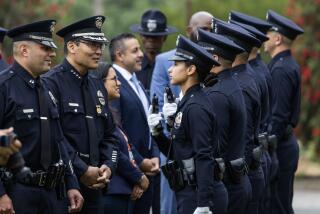San Bernardino may change minds on police use of surplus military equipment
Images of police in armored vehicles and tactical gear confronting protesters in Ferguson, Mo., led to a backlash against what critics have termed the militarization of law enforcement.
After last week’s mass shooting in San Bernardino, SWAT officers were hailed as heroes for using similar equipment to stop two heavily armed, Islamic State-inspired terrorists from inflicting even more harm.
With America’s fear level rising, having police officers who look like soldiers may be more acceptable to some. Despite the changed climate, however, civil rights advocates and law enforcement experts say the question is not whether local agencies should have basic military equipment but whether that equipment is deployed in the right situations.
Civil rights attorney Connie Rice said that, as the events in San Bernardino unfolded, she was glad to see officers in camouflage riding on armored vehicles to confront the couple who had just killed 14 people.
Police “don’t know whether they’re facing more bombs, suicide vests. They could be facing any number of things,” Rice said. “You expect that kind of response when you have that level of threat. You do not call this level of response out when there are just peaceful protesters.”
Scott Reitz, a former Los Angeles Police Department SWAT officer and instructor, agreed.
“You use a judicious and common-sense approach to when you apply it and when you don’t,” Reitz said. “In most of law enforcement, there’s a consensus that when you have people protesting and you look like you’re in Afghanistan, that may not be appropriate.”
SWAT teams increasingly are facing adversaries who are equipped like commandos and are willing to die for a cause. To win the battle, they must be equally armed, said Sid Heal, a retired L.A. County sheriff’s commander.
“Ultimately, it is the terrorist or the criminal who sets the standards, both in equipment and in readiness,” Heal said.
In the wake of last summer’s unrest in Ferguson, President Obama scaled back a program under which local authorities could obtain free surplus military equipment.
He took some items — including weaponized aircraft, bayonets and grenade launchers — off the list but allowed local agencies to continue acquiring more basic equipment, such as riot gear, guns and armored trucks with tires rather than tank treads.
This week, Rep. Norma Torres (D-Pomona) suggested that the surplus program be expanded, citing the San Bernardino massacre. Coupled with the appropriate training, a Torres spokeswoman said, that equipment can be critical in responding to major threats.
The San Bernardino County Sheriff’s Department — whose SWAT team engaged Syed Rizwan Farook and his wife, Tashfeen Malik, in the massive shootout Dec. 2 — has been one of California’s largest recipients under the surplus program, acquiring $5 million worth of gear that included armored trucks, helicopters and bomb detectors.
“We use those former military items to protect law enforcement and the public,” said Orange County Sheriff Sandra Hutchens, former head of counterterrorism for the Los Angeles County Sheriff’s Department. “Who do you think responds to an attack? The military? No. It’s local law enforcement.”
But Peter Bibring, director of police practices at the ACLU of Southern California, cautioned that “when a police department uses the same armored vehicle that might have been appropriate when chasing an active shooter, if they roll down a neighborhood street to serve a search warrant, that creates the impression that the community is under siege.”
Bibring, along with Rice, said that the surplus program needed to be revamped.
He pointed to the L.A. Unified School District’s police department — which received grenade launchers, a mine-resistant armored vehicle and automatic rifles — as an example of one that does not need to be equipped like an army.
“Agencies point to extremely rare incidents like [San Bernardino] as justification for this kind of equipment,” Bibring said. “But the equipment gets used in situations where it should never be used.”
cindy.chang@latimes.com
richard.winton@latimes.com
Twitter: @cindychangLA Twitter: @lacrimes
MORE ON SAN BERNARDINO
Amid Farook family violence, brothers were a study in contrasts
Victim of San Bernardino terror attack is recalled as ‘one of the good guys’
Memorial and prayer services held for victims of San Bernardino terror attack
More to Read
Sign up for Essential California
The most important California stories and recommendations in your inbox every morning.
You may occasionally receive promotional content from the Los Angeles Times.












